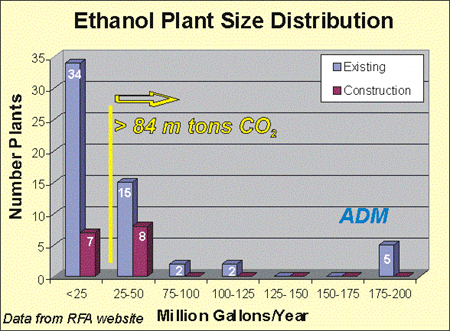
Model for Environmentally and Economically Sound Linked Energy Systems
Kansas Geological Survey
Open-file Report 2002-6

|
Model for Environmentally and Economically Sound Linked Energy Systems |
Kansas Geological Survey Open-file Report 2002-6 |
Minimum size in central Kansas appears to be about the size of the Russell model (25 million g/yr ethanol plant.
Maximum size as dictated by the potential EOR resource base and CO2 needs is greater than 200 million g/yr.
There does not appear to be market constraints (input or output) that would prevent much larger ethanol plants in central Kansas. Adequate feedstock (grains), cattle operations (enough for 50 Russell size plants in Kansas), and transportation (rail). Water may be the weakest link.
Current ethanol plant market is dominated by small (<25 MM g/yr) plants. Expanding ethanol demand provides opportunity for larger scale facilities and new construction shows trend towards larger plants.

| 1. | CO2 sales by ethanol plants are revenue enhancements not required for profitability. Location and size decisions are based on other market factors. | |
| Solution: Incentives to the ethanol industry through oil revenue sharing. | ||
| 2. | EOR process failure risk and associated capital risk (wellbore and surface facilities costs) are potentially very high in untested areas. | |
| Solution: Attempt in only the best areas (“Cherry-Pick” the oil patch) and apply appropriate reservoir “due diligence” including small pilot floods. | ||
| 3. | Pipeline capital cost risk is high if the EOR project fails. | |
| Solution: Lease compression equipment and balance risk through revenue sharing at both ends (with ethanol plant and oil operator). | ||
| 4. | Time horizon for appropriate reservoir screening and financial pro forma is long compared with the present ethanol expansion rate. | |
| Solution: Everything else equal, locate plants where there is CO2 EOR potential. | ||
|
|
e-mail : webadmin@kgs.ku.edu
Last updated March 2002
http://www.kgs.ku.edu/PRS/Poster/2002/2002-6/P3-04.html